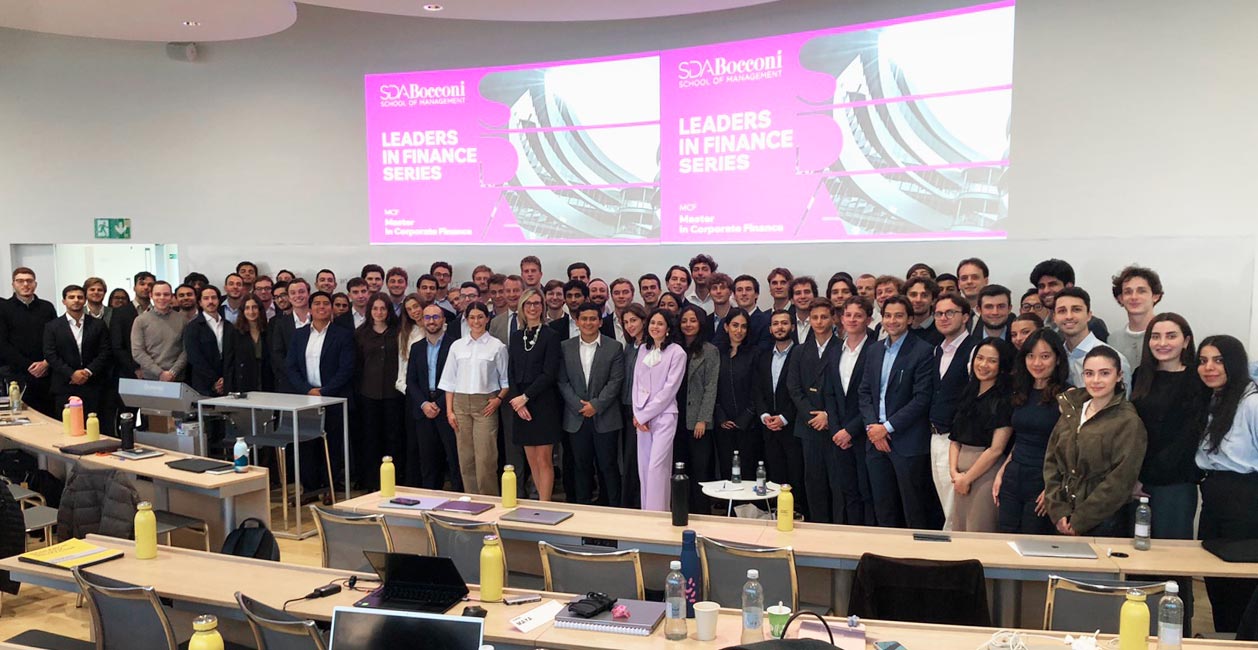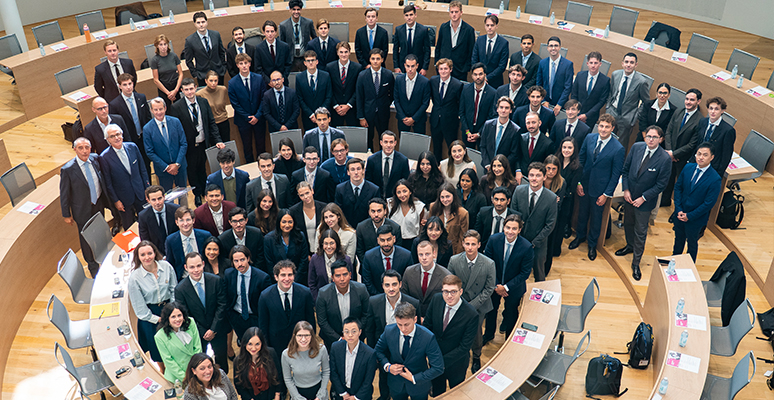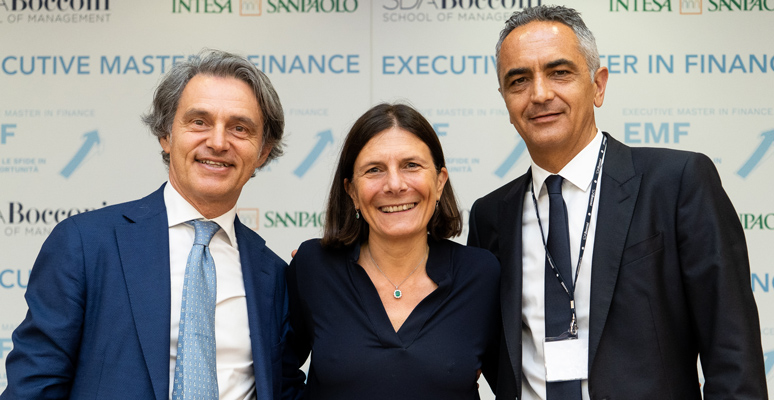The challenge for finance: measuring sustainability to impact behavior
Everyone is familiar with the definition of sustainability set out in the United Nations’ Bruntland Report in 1987: economic growth that meets the needs of present generations without compromising the ability of future generations to meet their own needs. But what does this mean in practical terms? In many fields, including economics and finance, something that is not measured is at risk of not being taken into consideration, and thus by definition is unable to change our behavior. It is therefore not strange that in the context of an Executive Master’s program in Finance, with an audience made up of guest CEOs and participants from different industries and attending the four specialization tracks in the program (Asset/Wealth Management, Banking Transformation, Corporate Finance&Control, Real Estate Transformation), there is a focus on the aspects of measurement at a corporate and financial institution level. This important task is one of the objectives of the 2022 edition of SDA Bocconi’s EMF - Executive Master in Finance, and was discussed in the 2022 EMF CEO Forum meeting entitled “Sustainable Values: from Metrics to Behavior.” The 2022 class participated in an intensive two-day event (EMF style!) called EMF CampUS, together with EMF Alumni from previous editions. The event followed other initiatives organized in 2021. As in the past, the EMF CEO Forum was an integral part of SDA Bocconi’s Strategic Finance Lab, which aims to investigate how finance supports the implementation of sustainable investments and the integration of ESG criteria by companies.
Sustainability, uncertainty, time horizon
The first topic covered in the CampUS designed by EMF Program Director Alessia Bezzecchi, and EMF Academic Director Andrea Beltratti concerned how to best combine the short and long term. As John Maynard Keynes said, in the long run “we are all dead,” and this is even truer considering the further deterioration of the environmental and social components of our systems. How can we prevent the death of our economy in the long run while reacting to short-term uncertainties? “By keeping the bar straight on long-term goals, conceived more broadly than we have done so far,” BNL Managing Director and Head of BNP Paribas Italy Elena Goitini, and Claudio Scardovi, CEO of Hope Sicaf Retail Benefit Corporation, answered in unison. “Creating sustainable value means creating value over time in terms of human, social and environmental capital,” Goitini suggested, “giving answers to the needs of customers and stakeholders, and taking into account the interests of both present and future generations by recognizing the interdependence between ESG dimensions. Companies are expected to make this long-term sustainability commitment because they can mobilize resources and influence people’s behavior.” Scardovi continued: “Short-term uncertainty is inescapable. The many black swans in recent years are evidence of this. Now structural, they can perhaps be attributed to economic, social and environmental ‘unsustainability’ in the management of our investment and consumption choices. This is partly the consequence of the short-sighted and biased economic and financial models we have used in recent years to guide our wealth-maximizing decisions. Hence the risk of ‘nealth’ – the nemesis of wealth –, with the sins of the fathers being passed on to future generations.”
ESG sustainability and the trade-off with financial sustainability
“Is there such a thing as a trade-off between economic growth and the pursuit of social and environmental goals? Do we have to give up material goods to make development sustainable, or is the theory of doing well while doing good true?”, Beltratti asked. The CEO of BNL elaborated in detail: “Academic studies point to the existence of a positive correlation between financial performance and ESG (Environment, Social, Governance) performance, but they generally do not take into account the costs companies incur to improve. On the other hand, more attention to the environmental and social implications creates a reputation for companies that increases their value, enables them to anticipate trends and reduces the impact of risks, improves operational efficiency, and reduces their overall risk profile. A concrete example is quitting certain businesses, as we did with the tobacco industry in 2017, and also not funding or investing in new coal-fired power plants around the world. In this way, you give up short-term profit with a view to building long-term trust.” Scardovi added: “In the short term, supply and demand can affect prices in various ways, but fundamentals prevail in the long term. So we can hope that what is sustainable will justify the surplus value already visible in green approaches today to confirm that ‘green is good,’ even in terms of returns. However, there are elements of risk: greenwashing (false communication by the economic players), green bubbles (bubbles on green stocks created by temporary market imbalances), green-flop (arbitrage activity by ‘bad’ players exploiting the good intentions of ‘good’ ones), greenflation (price increase caused by a ‘green conversion’ that is too hasty or not well planned and implemented), and greenfashion (sustainability as a fad bound to end up like many others, without really contributing to solving the problem).”
Sustainability and technology
Does technology really help reduce the trade-off between economic growth, and social and environmental sustainability? According to BNL’s CEO, “Technology is a positive factor in sustainability and survival of the banking sector, which is bound to change. There are many alternatives, from open banking to platformization to the creation of business ecosystems. One practical example concerns BNL’s Phoenix circular economy project, in which electronic appliances are reconditioned when possible or dismantled to recover the raw materials. It is a project that also includes the social element since workers are the inmates of Bollate prison, who are encouraged to return to active life. Let me add that banking and fintech are not competitors but allies, for example to better exploit the potential of the cloud.” The CEO of Hope added: “Technology is a critical element. To us, on the ‘gathering’ side, it can support our mission to democratize finance. On the ‘use’ side, it can support the businesses and projects we invest in to make them more sustainable, for example with precision agriculture and food (in agri-food), or new, less polluting materials and ‘carbon-capture’ technology (in urban regeneration projects). But let’s not forget that private initiative must be flanked by public policies, starting with the carbon tax – complemented by ‘green certificates’ – that must help incorporate the negative contribution of goods to the environment into their cost – punishing negative externalities just as certificates reward positive ones.”
ESG investing
Sustainability must be included in the processes of corporate and financial institutionsWhere do we stand on this? Professor Scardovi is clear: “Procedures create complexity and allow the regulator to monitor actions, but in themselves do not lead to the result. Governance is a key element: what matters most are companies’ shared values and incentives for decision-makers. For example, Hope has a Board of Directors that includes six non-executive members, and was established as a Benefit Corporation pursuing FSRD Article 8 investments. The Investment Committee makes suggestions but does not decide, the BoD with a majority of non-executives may not agree with the CEO’s proposals, and the Sustainability Committee adds expertise and insights on issues that are not strictly economic.”
BNL’s CEO went on to give other (specific) examples: “Our Corporate Sustainable Investing Committee is free to challenge any credit transaction, although in a large bank like ours you cannot limit yourself to credit. All other aspects, including policies on people and diversity, must take center stage.” Scardovi goes on: “Financial intermediaries must interact with entrepreneurs not only about products and processes, but also by fostering a cultural mutation of companies. It is not so much the sector they belong to or the initial level of efficiency that matter, since the role of investors is also to support sustainable growth in businesses that are the furthest from it. The most effective investors must become operating partners of companies, which in many cases do not know what to do practically to address sustainability goals. Without forgetting individual behavior: a recent study by the IPCC (Intergovernmental Panel on Climate Change) shows that CO2 emissions can be reduced by 50-70% simply by changing our behavior. It is therefore of paramount importance that interaction with businesses is also aimed at transforming behavior.” Goitini continued: “Companies need to understand that sustainability is not a demand from capital providers, but a need of theirs, a must-have that can enable an overall improvement in performance, as mentioned earlier.” On measures, opinions are almost unanimous: metrics are necessary since they allow companies to be pragmatic and objective, but they must be simple and shared to avoid manipulation. The European Commission’s environmental taxonomy is an element of progress that can reduce the significant heterogeneity implicit in current agency ratings.
Sustainable economic growth
Economic growth remains a necessary condition for sustainability, and public funding from the NRRP is a great opportunity for our country. With a word of warning from Scardovi: “The NRRP constitutes debt, which can only be paid back in a virtuous way if the projects funded by it enable a real increase in our country’s sustainable growth rate. Only through complementary action between public and private capital, and a selection of projects where return rates are higher than the cost of capital, can Italy look to the future with optimism. The NRRP is an opportunity but also a great responsibility for all citizens, not only in terms of monitoring but especially in our consumption and investment choices.”
Goitini shared this view: “Government action has enabled us to achieve many goals by giving a method and discipline of application. From here on, we must not lose what we have learned so far, in order to maintain positive discontinuities. Finance can help with an allocation process that is consistent with value drivers.” The issue of metrics came up again: “First and foremost, clear targets need to be set that not only drive economic growth but are also compatible with environmental and social targets, so that the overall resource allocation process is truly driven by sustainability.” Scardovi resumed: “For finance, the challenge is helping Italians transform the country, by identifying initiatives that can support its long-term sustainability and enabling direct and ‘equity-like’ investment of a part of our 5 trillion euros private savings in the real economy.”
Leadership in finance
Guiding the transformation also requires a new leadership model. Scardovi argued that “being a leader means getting up in the morning with a clear and ambitious vision to help change the world, while being humbly aware that it will take the contribution of many others to make a small but tangible difference. Leaders cannot just focus on relationships, be so-called power brokers, as many people think and advocate. They should be able to inspire and bring others on board; and also get directly involved, leading by example. Great managers not only put others in a position to do their best, but also work hands-on, ‘infecting’ others with their positive example and conveying emotion and passion.” Goitini agreed: “Leadership styles should fit the context. Leaders need a lot of energy, and should serve the objective. In three words: authenticity, generosity, curiosity. To become a good leader, I think giving and receiving feedback is really useful and instructive: especially the less positive ones are a gift that we carry with us every day in our working life. They are opportunities to challenge ourselves and grow, becoming aware of our aptitudes but above all of the areas of improvement we should invest in. How is it possible to succeed in all this? By learning to combine commitment and dedication with fun. Let your passions “contaminate” you: the time you devote to them will be an opportunity to free your mind and leave room for insights. To be good leaders, keep your direction well in mind, walk your own path letting others inspire you and be a source of inspiration yourself, facing the challenges you will come across every day in an innovative, visionary and optimistic way. Only by being yourself will you be able to be a leader in your company.”
SDA Bocconi School of Management
Leaders in Finance: Valeria Rebulla, Chief ...

SDA Bocconi welcomes the Class of 2025: a ...

Related Programs

- Start Date
- Duration
- Format
- Language
- 7 Nov 2025
- 1 day
- Class
- English

- Start date
- Duration
- Format
- Language
- 7 Nov 2025
- 12 Days
- Class
- Italian
Approfondire le i principi e le prassi più rilevanti in ambito Amministrazione, Finanza e Controllo per costruire un quadro organico e integrato delle conoscenze.

- Start date
- Duration
- Format
- Language
- 7 Nov 2025
- 4,5 days
- Class
- Italian
Approfondire gli aspetti economici, giuridici e fiscali delle operazioni societarie straordinarie e il loro impatto economico e sulla situazione patrimoniale.



